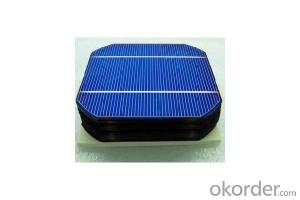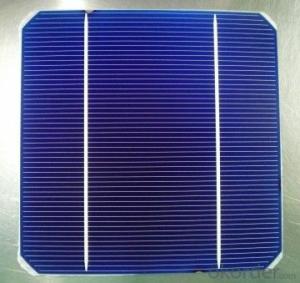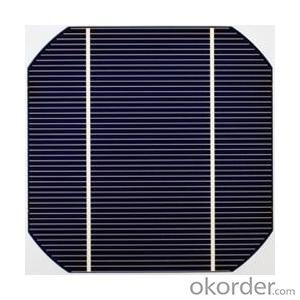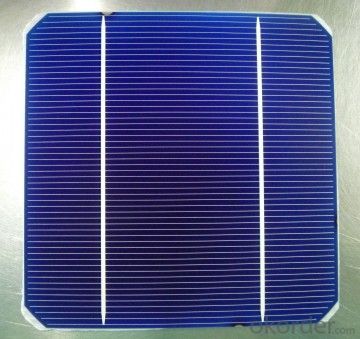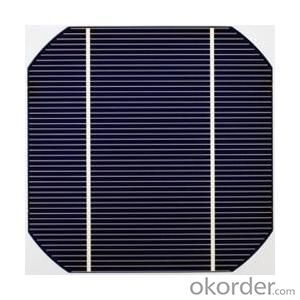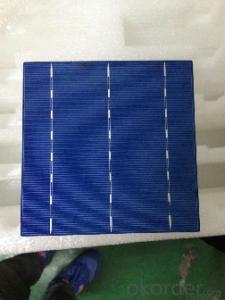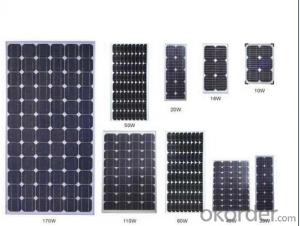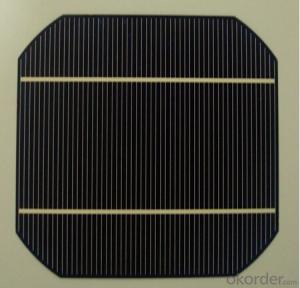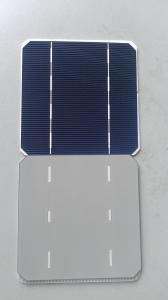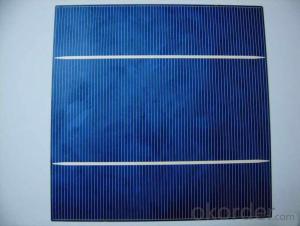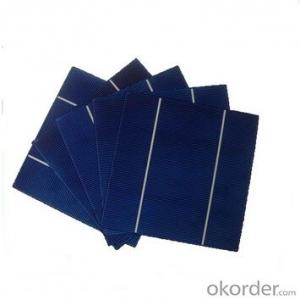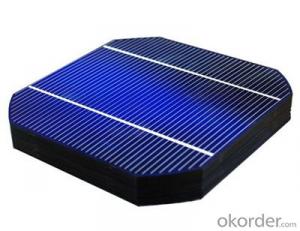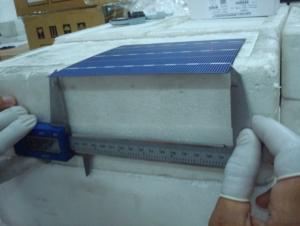125*125mm High Efficiency Mono Multijunction Solar Cells A Grade Silicon Solar Cell Top Quality Monocrystalline for Sale
- Loading Port:
- China main port
- Payment Terms:
- TT or LC
- Min Order Qty:
- 1000 watt
- Supply Capability:
- 200000 watt/month
OKorder Service Pledge
OKorder Financial Service
You Might Also Like
Specification





FAQ
Q: Could you give me a brief introduction of your company and products?
A: CNBM is the abbreviation of China National Building Material Group Corp, a State-owned corporation under the jurisdiction of National Central Government of China, and we own over 200 subsidiaries and factories. We are an important external business platform of CNBM Group. Now we have several manufacturing bases in China, with capacity of 220MW, and products ranged from c-Si to a-Si panels which are certified by authorized laboratories,for example TUV,VDE and UL.
Q: What price for each watt?
A: It depends on the quantity, delivery date and payment terms, generally Large Quantity and Low Price
Q: Do you have the CE, TUV, UL Certification?
A: We’ve already passed all the tests, and any certificate is available.
Q: Have you ever sold your products to companies in my country?
A: Of course, we have customers in all general PV markets, but I think we should expand our market share along with the market growth.
Basic theory of Photovoltaic cells
Photovoltaics is the direct conversion of light into electricity at the atomic level. Some materials exhibit a property known as the photoelectric effect that causes them to absorb photons of light and release electrons. When these free electrons are captured, an electric current results that can be used as electricity.
The diagram above illustrates the operation of a basic photovoltaic cell, also called a solar cell. Solar cells are made of the same kinds of semiconductor materials, such as silicon, used in the microelectronics industry. For solar cells, a thin semiconductor wafer is specially treated to form an electric field, positive on one side and negative on the other. When light energy strikes the solar cell, electrons are knocked loose from the atoms in the semiconductor material. If electrical conductors are attached to the positive and negative sides, forming an electrical circuit, the electrons can be captured in the form of an electric current -- that is, electricity. This electricity can then be used to power a load, such as a light or a tool.
A number of solar cells electrically connected to each other and mounted in a support structure or frame is called a photovoltaic module. Modules are designed to supply electricity at a certain voltage, such as a common 12 volts system. The current produced is directly dependent on how much light strikes the module.

Multiple modules can be wired together to form an array. In general, the larger the area of a module or array, the more electricity that will be produced. Photovoltaic modules and arrays produce direct-current (dc) electricity. They can be connected in both series and parallel electrical arrangements to produce any required voltage and current combination.
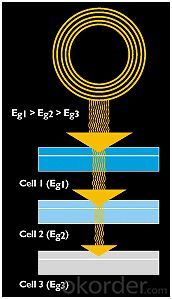
Photovoltaic cells how they work
Today's most common PV devices use a single junction, or interface, to create an electric field within a semiconductor such as a PV cell. In a single-junction PV cell, only photons whose energy is equal to or greater than the band gap of the cell material can free an electron for an electric circuit. In other words, the photovoltaic response of single-junction cells is limited to the portion of the sun's spectrum whose energy is above the band gap of the absorbing material, and lower-energy photons are not used.
One way to get around this limitation is to use two (or more) different cells, with more than one band gap and more than one junction, to generate a voltage. These are referred to as "multijunction" cells. Multijunction devices can achieve a higher total conversion efficiency because they can convert more of the energy spectrum of light to electricity.
As shown below, a multijunction device is a stack of individual single-junction cells in descending order of band gap (Eg). The top cell captures the high-energy photons and passes the rest of the photons on to be absorbed by lower-band-gap cells.
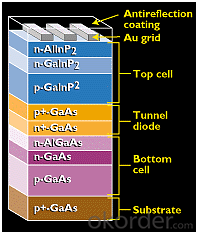
Much of today's research in multijunction cells focuses on gallium arsenide as one (or all) of the component cells. Such cells have reached efficiencies of around 35% under concentrated sunlight. Other materials studied for multijunction devices have been amorphous silicon and copper indium diselenide.
As an example, the multijunction device below uses a top cell of gallium indium phosphide, "a tunnel junction," to aid the flow of electrons between the cells, and a bottom cell of gallium arsenide.
- Q: How many years should I spend in the solar cell industry to be a good solar cells sales person?
- A good solar cells should be equiped with both solar cells knowledge and good sales skills, and with very good people skills. Only in this way, you will be a good one.
- Q: How much energy can a solar cell generate?
- The amount of energy a solar cell can generate depends on various factors such as its size, efficiency, and the available sunlight. On average, a standard solar cell can generate around 200 to 400 watts of electricity per square meter in optimal conditions. However, technological advancements continue to improve the efficiency of solar cells, allowing for higher energy generation in the future.
- Q: Can solar cells be used for indoor applications?
- Yes, solar cells can be used for indoor applications. While they are primarily designed for outdoor use to harness sunlight, advancements in technology have made it possible to use solar cells indoors as well. Indoor solar cells can be used to power various devices and systems, such as indoor lighting, small electronics, and even indoor farming setups. Additionally, solar cells can also be used in combination with battery storage to provide a continuous and renewable power source for indoor applications.
- Q: How do solar cells affect air pollution?
- Solar cells help reduce air pollution by producing electricity without emitting harmful pollutants or greenhouse gases. Traditional energy sources such as coal, oil, and gas power plants release pollutants like sulfur dioxide, nitrogen oxide, and carbon dioxide, contributing to air pollution and climate change. Solar cells, on the other hand, convert sunlight directly into electricity, generating clean and renewable energy. This reduces the need for fossil fuel-based electricity generation, thereby reducing air pollution and improving air quality.
- Q: What is the role of solar cells in powering agricultural irrigation?
- Solar cells play a crucial role in powering agricultural irrigation as they convert sunlight into electricity, providing a renewable and sustainable energy source. By harnessing solar power, farmers can operate irrigation systems efficiently, reducing reliance on fossil fuels and minimizing carbon emissions. This enables them to irrigate crops effectively, improving yields and ensuring sustainable agricultural practices.
- Q: How do solar cells perform in areas with high levels of salt spray?
- Solar cells generally perform well in areas with high levels of salt spray. The materials used in solar cells are designed to be resistant to corrosion and degradation caused by salt exposure. However, regular cleaning and maintenance may be required to ensure optimal performance and prevent any potential buildup of salt deposits on the surface of the solar panels.
- Q: Can solar cells be used in commercial buildings?
- Yes, solar cells can be used in commercial buildings. In fact, many commercial buildings worldwide are increasingly incorporating solar panels to generate renewable energy and reduce their reliance on traditional power sources. This not only helps businesses save on electricity costs but also contributes to a more sustainable and environmentally friendly operation.
- Q: What is the typical warranty for solar cells?
- The typical warranty for solar cells ranges from 10 to 25 years, depending on the manufacturer and type of solar cell.
- Q: What is the role of monitoring systems in solar cell systems?
- The role of monitoring systems in solar cell systems is to continuously monitor and analyze the performance and efficiency of the solar panels. It allows for real-time tracking of the energy production, detecting any malfunctions or abnormalities, and identifying potential issues that may affect the overall system performance. This data helps in optimizing the efficiency of the solar cell system, ensuring maximum energy generation, and enabling timely maintenance and repairs. Monitoring systems also provide valuable insights for system optimization, energy consumption analysis, and performance evaluation.
- Q: Can solar cells be used in shopping malls?
- Yes, solar cells can definitely be used in shopping malls. They are a sustainable and environmentally-friendly source of energy that can be integrated into the mall's infrastructure to reduce electricity costs and carbon footprint.
Send your message to us
125*125mm High Efficiency Mono Multijunction Solar Cells A Grade Silicon Solar Cell Top Quality Monocrystalline for Sale
- Loading Port:
- China main port
- Payment Terms:
- TT or LC
- Min Order Qty:
- 1000 watt
- Supply Capability:
- 200000 watt/month
OKorder Service Pledge
OKorder Financial Service
Similar products
Hot products
Hot Searches
Related keywords
